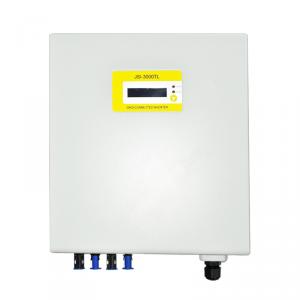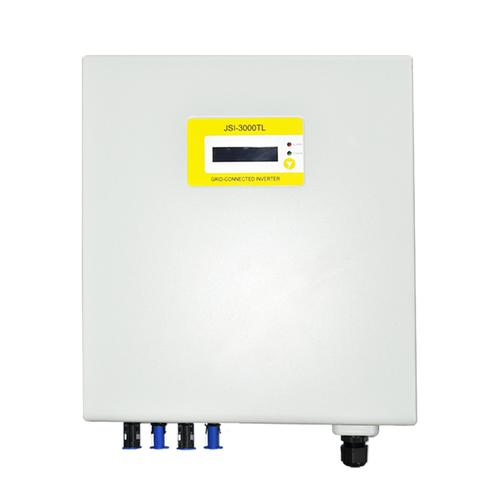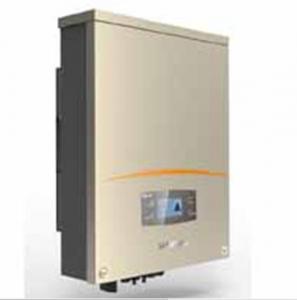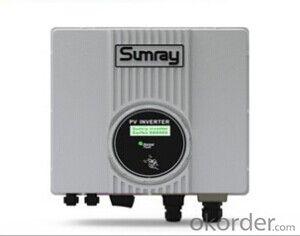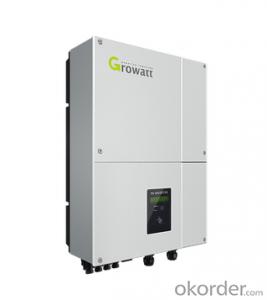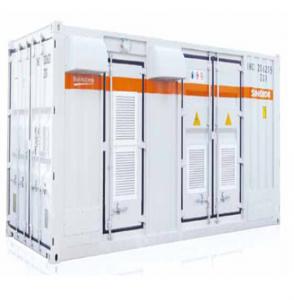Eg4 Solar Inverter 6000W Grid Connected Solar PV Inverter
OKorder Service Pledge
Quality Product, Order Online Tracking, Timely Delivery
OKorder Financial Service
Credit Rating, Credit Services, Credit Purchasing
You Might Also Like
Grid connected solar PV inverter 6000W
◆ Compact size and high power density
◆ High speed MPPT for real time power tracking and improved energy harvesting
◆ Transformerless operation for highest efficiency 97%
◆ High overload capability under most ambient conditions
◆ Certified grid connected operation according to the international standards
◆ True sine wave output
◆ Integrated RS485/RS232 serial communications
◆ Multi-language LCD display
| MODEL | 1100TL | 1500TL | 2000TL | 2500TL | 3000TL | 3600TL | 5000TL | 6000TL |
| Max. DC Input Power(W) | 1200 | 1750 | 2300 | 2700 | 3660 | 3750 | 5300 | 6400 |
| Max DC Voltage(Vdc) | 450 | 450 | 500 | 550 | ||||
| MPPT Operating Range(Vdc) | 60~450 | 100~450 | 100~500 | |||||
| Number of Parallel Inputs | 1 | 2 | 3 | |||||
| Number of MPPT Trackers | 1 | |||||||
| Max. Input Current(A) | 11.7 | 10 | 13 | 14.5 | 20 | 20 | 22.5 | 27.5 |
| Nominal Output Power(W) | 1100 | 1500 | 2000 | 2490 | 3000 | 3600 | 4600 | 6000 |
| Max. Output Power(W) | 1100 | 1650 | 2200 | 2490 | 3400 | 3600 | 5000 | 6000 |
| Nominal Output Current(A) | 4.8 | 6.5 | 8.7 | 10.8 | 13 | 15.7 | 20 | 26 |
| Max. Output Current(A) | 5.7 | 7.9 | 10.5 | 12 | 15.7 | 16 | 24 | 29.3 |
| Nominal AC Output Voltage(Vac) | 230 | |||||||
| AC Output voltage range (Vac)* | 190~265 | |||||||
| AC Grid frequency range (Hz)* | 50±5 | |||||||
| Power Factor (cosφ) | >0.99 | |||||||
| THDI | <3%(at nominal output power) | |||||||
| Max.efficiency | 96.50% | 96.50% | 97.00% | 97.10% | 97.20% | 97.30% | 97.40% | 97.40% |
| Euro.efficiency | 95.40% | 95.50% | 96.20% | 96.30% | 96.40% | 96.60% | 96.80% | 96.80% |
| MPPT. efficiency | 99.60% | 99.60% | 99.60% | 99.60% | 99.60% | 99.60% | 99.60% | 99.60% |
| Operating Temperature(℃) | -25~+60 | |||||||
| Noise typical[dB(A)] | ≤20dB(A) | |||||||
| Operating Consumption(W) | 0 | |||||||
| Electrical Isolation | Transformerless | |||||||
| Cooling Concept | Natural cooling | |||||||
| Protect Level | IP65 | |||||||
| Communication | RS232(WiFi optional) | |||||||
| Dimension (W×D×H)(mm) | 345*152*315 | 345*152*355 | 345*152*385 | 345*152*505 | 345*162*573 | |||
| Weight (Kg) | 12 | 13 | 15 | 19 | 24 | |||
| *AC grid voltage range and frequency range depend on local standards | ||||||||
- Q: How does a solar inverter handle varying solar irradiance levels?
- A solar inverter handles varying solar irradiance levels by continuously monitoring the incoming solar energy and adjusting its operations accordingly. It converts the direct current (DC) produced by solar panels into alternating current (AC) that can be used to power electrical devices. When the solar irradiance levels are high, the inverter optimizes the power output to match the maximum potential of the solar panels. Conversely, during low solar irradiance, the inverter adjusts its operations to ensure optimal efficiency and power generation. This adaptive nature of solar inverters allows them to efficiently harness solar energy under varying conditions.
- Q: How do you calculate the power output of a solar inverter?
- To calculate the power output of a solar inverter, you need to multiply the input voltage by the input current. This will give you the input power. Then, multiply the efficiency of the inverter by the input power to get the output power.
- Q: Can a solar inverter be used with a ground-mounted solar array?
- Yes, a solar inverter can be used with a ground-mounted solar array. The inverter is responsible for converting the direct current (DC) generated by the solar panels into alternating current (AC) that can be used to power household appliances or be fed back into the grid. Whether the solar array is ground-mounted or roof-mounted, the inverter's function remains the same.
- Q: How does a solar inverter handle voltage and frequency variations caused by voltage sags and swells?
- Voltage and frequency variations caused by voltage sags and swells are effectively managed by the diverse mechanisms equipped in a solar inverter. When there is a voltage sag or swell in the electrical grid, the solar inverter employs a technique known as Maximum Power Point Tracking (MPPT) to regulate the power output from the solar panels. During a voltage sag, where the grid voltage drops below the standard level, the solar inverter adjusts its MPPT algorithms to ensure that the solar panels continue operating at their maximum power point. This guarantees that the inverter extracts the most available power from the panels and compensates for the reduced grid voltage. By dynamically adjusting the operating point of the panels, the inverter mitigates the effects of the voltage sag and maintains an optimal power output. Similarly, in the case of a voltage swell, where the grid voltage exceeds the normal level, the solar inverter once again utilizes its MPPT capabilities to regulate power output. It adjusts the panels' operating point to prevent them from surpassing their rated voltage, thereby safeguarding them from potential damage. This allows the inverter to effectively handle the increased grid voltage and prevent any negative impact on the solar panels. Aside from voltage regulation, a solar inverter also addresses frequency variations caused by voltage sags and swells. It is designed to synchronize with the grid frequency and uphold a stable output frequency. When the grid frequency deviates from the normal range, the inverter adapts its internal control systems to match the grid frequency. This synchronization ensures that the power output from the inverter aligns with the grid requirements, facilitating seamless integration of solar energy into the electrical system. In conclusion, a solar inverter effectively manages voltage and frequency variations caused by voltage sags and swells by utilizing MPPT algorithms, voltage regulation mechanisms, and frequency synchronization capabilities. These features enable the inverter to adapt to changing grid conditions, maximize power extraction from the solar panels, and maintain a stable and reliable power output.
- Q: What is the PV inverter starting voltage
- The inverter not only has the function of direct current conversion, but also has the function of maximizing the performance of the solar cell and the system fault protection function. (With grid system), automatic voltage adjustment function (for network connection), DC detection function (for network connection), DC grounding detection (for network connection), automatic power control function Function (for grid connection). Here is a brief introduction to automatic operation and shutdown function and maximum power tracking control function.
- Q: How does a solar inverter handle variations in AC load demand?
- A solar inverter handles variations in AC load demand by continuously monitoring the load demand and adjusting the amount of power it delivers from the solar panels accordingly. This is achieved through advanced control algorithms that optimize the conversion of DC power generated from the solar panels into AC power that matches the load demand. The inverter maintains a stable voltage and frequency output, ensuring that the electrical devices connected to it receive a consistent and reliable power supply, even when there are fluctuations in the AC load demand.
- Q: Can a solar inverter be used with different types of energy storage systems?
- Yes, a solar inverter can be used with different types of energy storage systems. Solar inverters are typically designed to convert the direct current (DC) generated by solar panels into alternating current (AC) that can be used to power household appliances and other electrical devices. They can be integrated with various energy storage technologies such as batteries, supercapacitors, and flywheels to store excess energy generated by the solar panels for later use. The compatibility between the solar inverter and the energy storage system may depend on factors such as voltage requirements, capacity, and communication protocols.
- Q: Can a solar inverter be connected to a computer or smartphone?
- Yes, a solar inverter can be connected to a computer or smartphone. Many modern solar inverters come with built-in Wi-Fi or Bluetooth capabilities that allow them to connect to these devices. Through dedicated mobile apps or software, users can monitor their solar system's performance, adjust settings, and receive real-time data and alerts directly on their computer or smartphone.
- Q: Can a solar inverter be used with a solar-powered cooling system?
- Yes, a solar inverter can be used with a solar-powered cooling system. A solar inverter is responsible for converting the direct current (DC) electricity generated by solar panels into alternating current (AC) electricity that can be used to power various appliances, including cooling systems. By integrating a solar inverter into a solar-powered cooling system, the system can effectively harness solar energy to operate and provide cooling without relying on external power sources.
- Q: What safety features should a solar inverter have?
- A solar inverter should have several safety features, including overvoltage protection, overcurrent protection, ground fault protection, and arc fault protection. Additionally, it should have robust insulation to prevent electrical shock hazards and be equipped with sensors to monitor temperature and prevent overheating. Finally, it should have a secure enclosure to protect against environmental factors such as water, dust, and debris.
Send your message to us
Eg4 Solar Inverter 6000W Grid Connected Solar PV Inverter
OKorder Service Pledge
Quality Product, Order Online Tracking, Timely Delivery
OKorder Financial Service
Credit Rating, Credit Services, Credit Purchasing
Similar products
Hot products
Hot Searches
Related keywords
